Comparison of Sole Trader, Partnership, and Company
VerifiedAdded on 2023/01/18
|9
|2799
|83
AI Summary
This document provides a comparison of the sole trader, partnership, and company business structures. It discusses the setup, administrative cost, and burden of each structure. It also explores the contracts between partners and outsiders, as well as contracts between individuals in a company with outsiders. Additionally, it covers the duties of partners in a partnership firm and the duties of company officers and directors.
Contribute Materials
Your contribution can guide someone’s learning journey. Share your
documents today.

1
Title Page
Name of the student
Student ID
Title Page
Name of the student
Student ID
Secure Best Marks with AI Grader
Need help grading? Try our AI Grader for instant feedback on your assignments.
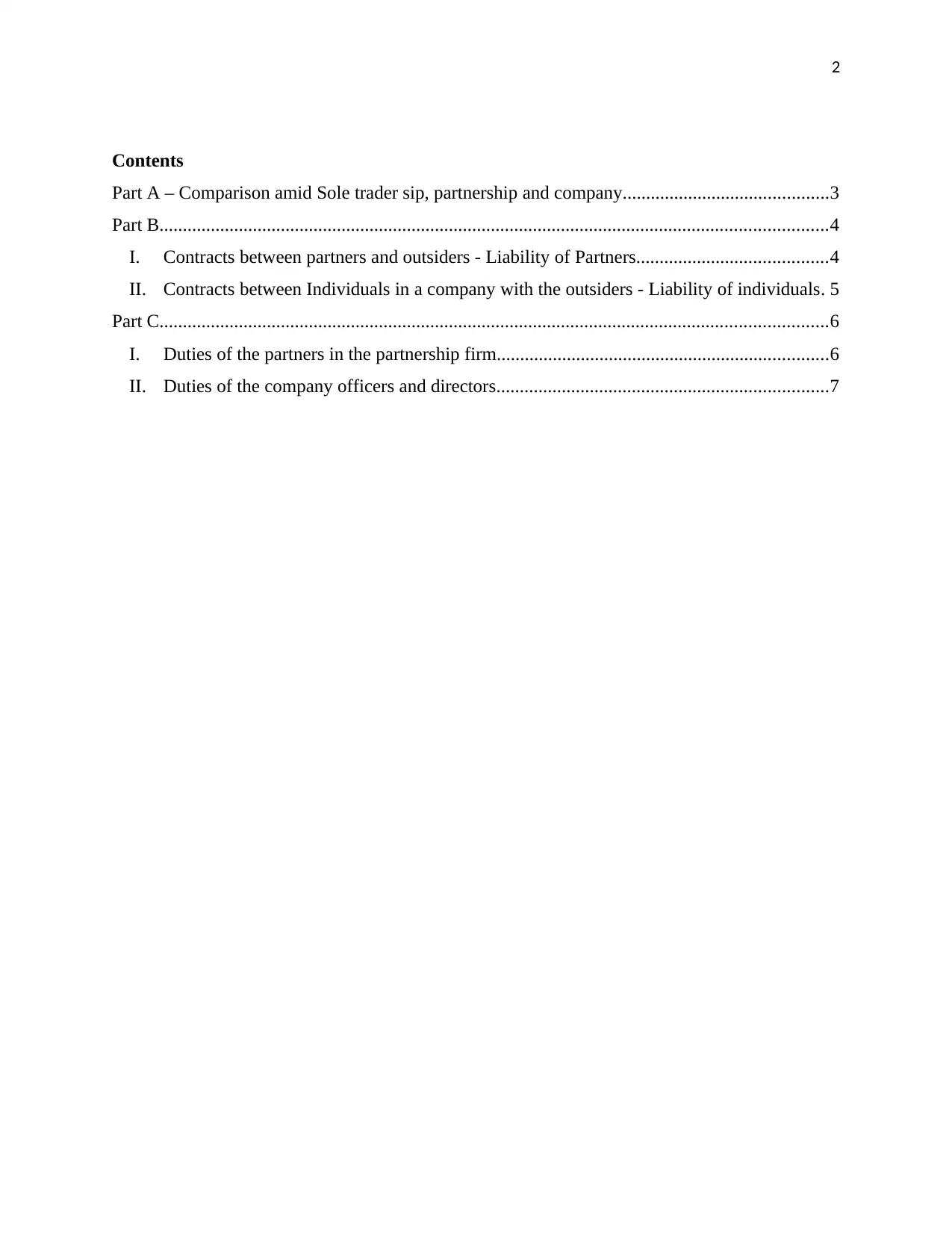
2
Contents
Part A – Comparison amid Sole trader sip, partnership and company............................................3
Part B...............................................................................................................................................4
I. Contracts between partners and outsiders - Liability of Partners.........................................4
II. Contracts between Individuals in a company with the outsiders - Liability of individuals. 5
Part C...............................................................................................................................................6
I. Duties of the partners in the partnership firm.......................................................................6
II. Duties of the company officers and directors.......................................................................7
Contents
Part A – Comparison amid Sole trader sip, partnership and company............................................3
Part B...............................................................................................................................................4
I. Contracts between partners and outsiders - Liability of Partners.........................................4
II. Contracts between Individuals in a company with the outsiders - Liability of individuals. 5
Part C...............................................................................................................................................6
I. Duties of the partners in the partnership firm.......................................................................6
II. Duties of the company officers and directors.......................................................................7
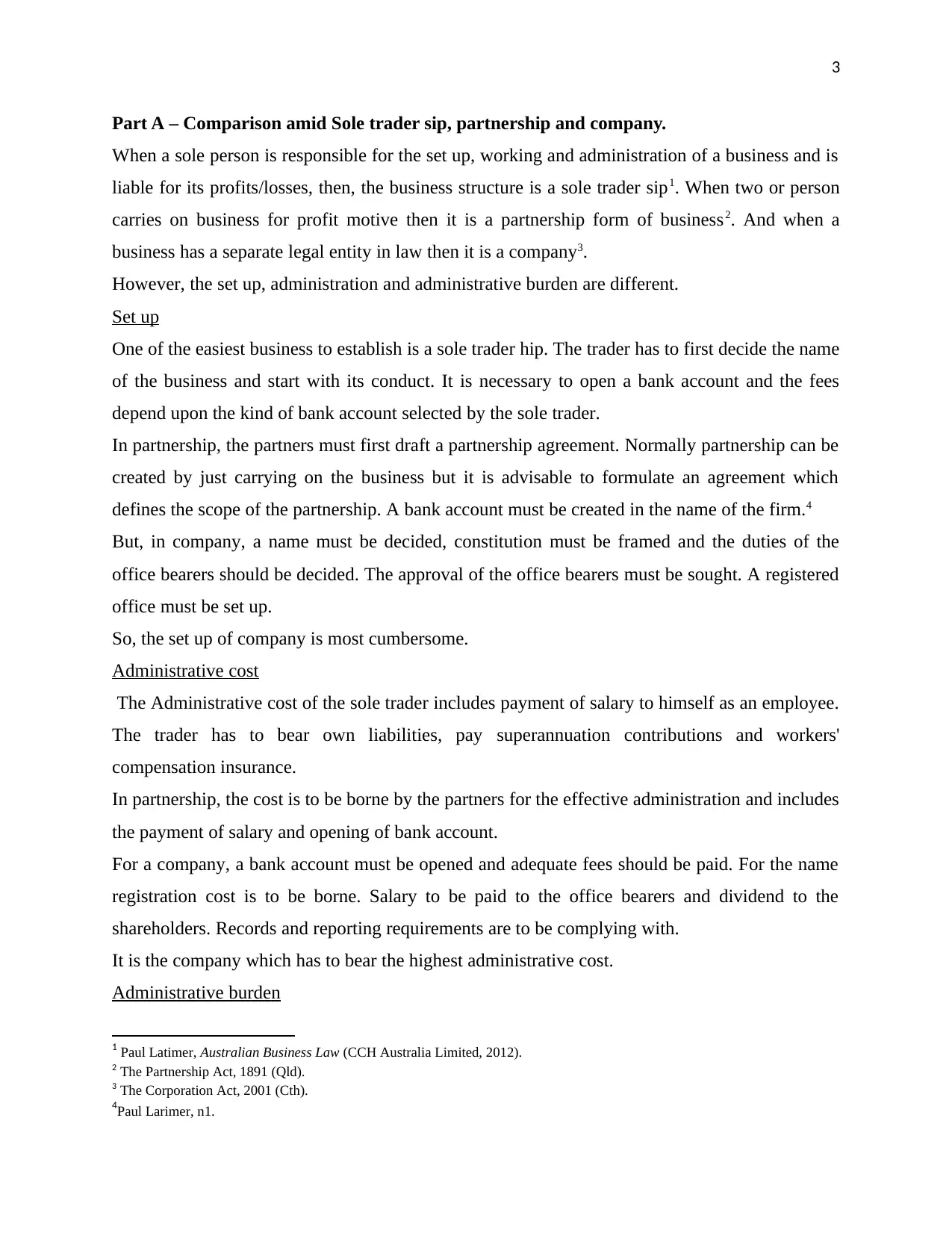
3
Part A – Comparison amid Sole trader sip, partnership and company.
When a sole person is responsible for the set up, working and administration of a business and is
liable for its profits/losses, then, the business structure is a sole trader sip1. When two or person
carries on business for profit motive then it is a partnership form of business2. And when a
business has a separate legal entity in law then it is a company3.
However, the set up, administration and administrative burden are different.
Set up
One of the easiest business to establish is a sole trader hip. The trader has to first decide the name
of the business and start with its conduct. It is necessary to open a bank account and the fees
depend upon the kind of bank account selected by the sole trader.
In partnership, the partners must first draft a partnership agreement. Normally partnership can be
created by just carrying on the business but it is advisable to formulate an agreement which
defines the scope of the partnership. A bank account must be created in the name of the firm.4
But, in company, a name must be decided, constitution must be framed and the duties of the
office bearers should be decided. The approval of the office bearers must be sought. A registered
office must be set up.
So, the set up of company is most cumbersome.
Administrative cost
The Administrative cost of the sole trader includes payment of salary to himself as an employee.
The trader has to bear own liabilities, pay superannuation contributions and workers'
compensation insurance.
In partnership, the cost is to be borne by the partners for the effective administration and includes
the payment of salary and opening of bank account.
For a company, a bank account must be opened and adequate fees should be paid. For the name
registration cost is to be borne. Salary to be paid to the office bearers and dividend to the
shareholders. Records and reporting requirements are to be complying with.
It is the company which has to bear the highest administrative cost.
Administrative burden
1 Paul Latimer, Australian Business Law (CCH Australia Limited, 2012).
2 The Partnership Act, 1891 (Qld).
3 The Corporation Act, 2001 (Cth).
4Paul Larimer, n1.
Part A – Comparison amid Sole trader sip, partnership and company.
When a sole person is responsible for the set up, working and administration of a business and is
liable for its profits/losses, then, the business structure is a sole trader sip1. When two or person
carries on business for profit motive then it is a partnership form of business2. And when a
business has a separate legal entity in law then it is a company3.
However, the set up, administration and administrative burden are different.
Set up
One of the easiest business to establish is a sole trader hip. The trader has to first decide the name
of the business and start with its conduct. It is necessary to open a bank account and the fees
depend upon the kind of bank account selected by the sole trader.
In partnership, the partners must first draft a partnership agreement. Normally partnership can be
created by just carrying on the business but it is advisable to formulate an agreement which
defines the scope of the partnership. A bank account must be created in the name of the firm.4
But, in company, a name must be decided, constitution must be framed and the duties of the
office bearers should be decided. The approval of the office bearers must be sought. A registered
office must be set up.
So, the set up of company is most cumbersome.
Administrative cost
The Administrative cost of the sole trader includes payment of salary to himself as an employee.
The trader has to bear own liabilities, pay superannuation contributions and workers'
compensation insurance.
In partnership, the cost is to be borne by the partners for the effective administration and includes
the payment of salary and opening of bank account.
For a company, a bank account must be opened and adequate fees should be paid. For the name
registration cost is to be borne. Salary to be paid to the office bearers and dividend to the
shareholders. Records and reporting requirements are to be complying with.
It is the company which has to bear the highest administrative cost.
Administrative burden
1 Paul Latimer, Australian Business Law (CCH Australia Limited, 2012).
2 The Partnership Act, 1891 (Qld).
3 The Corporation Act, 2001 (Cth).
4Paul Larimer, n1.
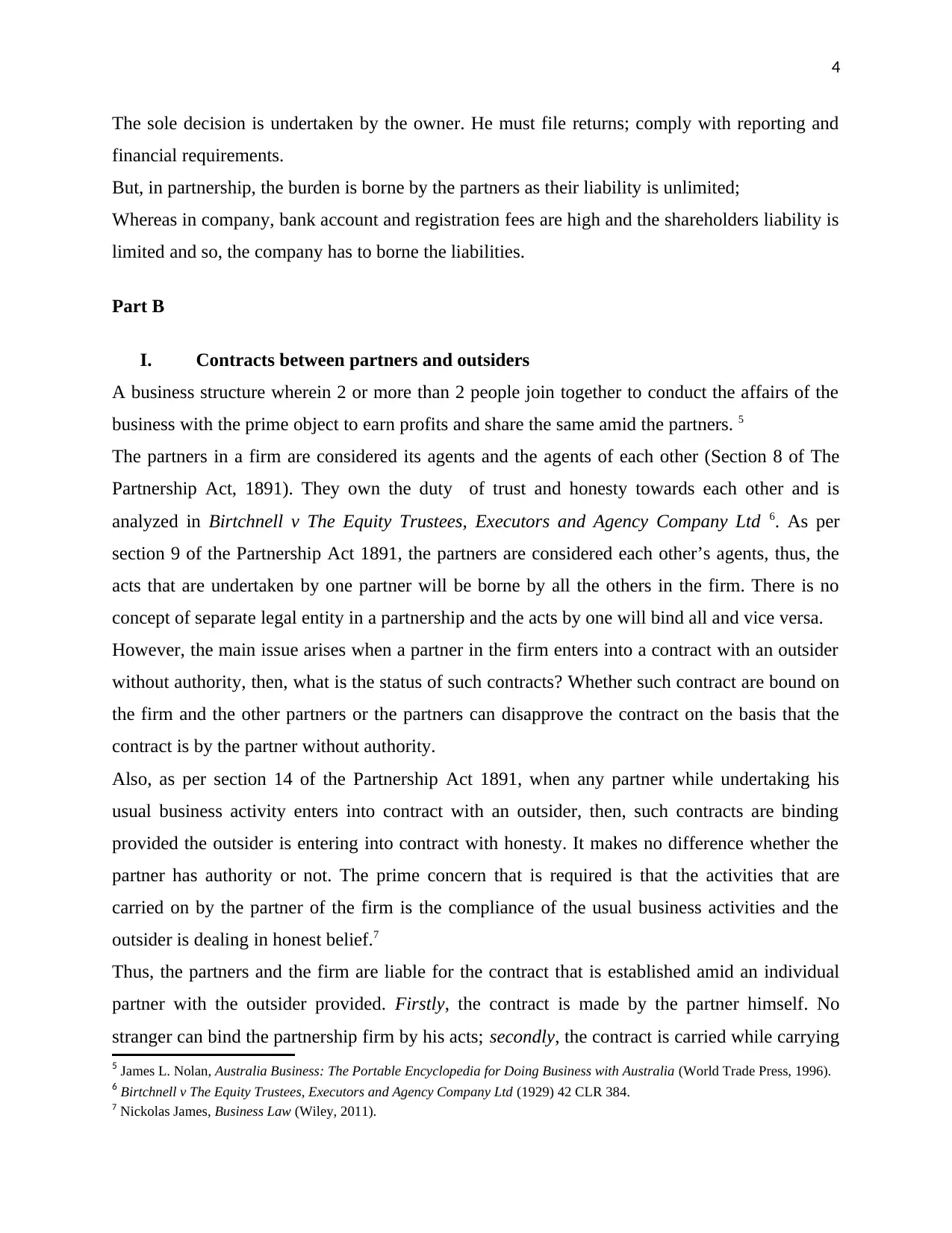
4
The sole decision is undertaken by the owner. He must file returns; comply with reporting and
financial requirements.
But, in partnership, the burden is borne by the partners as their liability is unlimited;
Whereas in company, bank account and registration fees are high and the shareholders liability is
limited and so, the company has to borne the liabilities.
Part B
I. Contracts between partners and outsiders
A business structure wherein 2 or more than 2 people join together to conduct the affairs of the
business with the prime object to earn profits and share the same amid the partners. 5
The partners in a firm are considered its agents and the agents of each other (Section 8 of The
Partnership Act, 1891). They own the duty of trust and honesty towards each other and is
analyzed in Birtchnell v The Equity Trustees, Executors and Agency Company Ltd 6. As per
section 9 of the Partnership Act 1891, the partners are considered each other’s agents, thus, the
acts that are undertaken by one partner will be borne by all the others in the firm. There is no
concept of separate legal entity in a partnership and the acts by one will bind all and vice versa.
However, the main issue arises when a partner in the firm enters into a contract with an outsider
without authority, then, what is the status of such contracts? Whether such contract are bound on
the firm and the other partners or the partners can disapprove the contract on the basis that the
contract is by the partner without authority.
Also, as per section 14 of the Partnership Act 1891, when any partner while undertaking his
usual business activity enters into contract with an outsider, then, such contracts are binding
provided the outsider is entering into contract with honesty. It makes no difference whether the
partner has authority or not. The prime concern that is required is that the activities that are
carried on by the partner of the firm is the compliance of the usual business activities and the
outsider is dealing in honest belief.7
Thus, the partners and the firm are liable for the contract that is established amid an individual
partner with the outsider provided. Firstly, the contract is made by the partner himself. No
stranger can bind the partnership firm by his acts; secondly, the contract is carried while carrying
5 James L. Nolan, Australia Business: The Portable Encyclopedia for Doing Business with Australia (World Trade Press, 1996).
6 Birtchnell v The Equity Trustees, Executors and Agency Company Ltd (1929) 42 CLR 384.
7 Nickolas James, Business Law (Wiley, 2011).
The sole decision is undertaken by the owner. He must file returns; comply with reporting and
financial requirements.
But, in partnership, the burden is borne by the partners as their liability is unlimited;
Whereas in company, bank account and registration fees are high and the shareholders liability is
limited and so, the company has to borne the liabilities.
Part B
I. Contracts between partners and outsiders
A business structure wherein 2 or more than 2 people join together to conduct the affairs of the
business with the prime object to earn profits and share the same amid the partners. 5
The partners in a firm are considered its agents and the agents of each other (Section 8 of The
Partnership Act, 1891). They own the duty of trust and honesty towards each other and is
analyzed in Birtchnell v The Equity Trustees, Executors and Agency Company Ltd 6. As per
section 9 of the Partnership Act 1891, the partners are considered each other’s agents, thus, the
acts that are undertaken by one partner will be borne by all the others in the firm. There is no
concept of separate legal entity in a partnership and the acts by one will bind all and vice versa.
However, the main issue arises when a partner in the firm enters into a contract with an outsider
without authority, then, what is the status of such contracts? Whether such contract are bound on
the firm and the other partners or the partners can disapprove the contract on the basis that the
contract is by the partner without authority.
Also, as per section 14 of the Partnership Act 1891, when any partner while undertaking his
usual business activity enters into contract with an outsider, then, such contracts are binding
provided the outsider is entering into contract with honesty. It makes no difference whether the
partner has authority or not. The prime concern that is required is that the activities that are
carried on by the partner of the firm is the compliance of the usual business activities and the
outsider is dealing in honest belief.7
Thus, the partners and the firm are liable for the contract that is established amid an individual
partner with the outsider provided. Firstly, the contract is made by the partner himself. No
stranger can bind the partnership firm by his acts; secondly, the contract is carried while carrying
5 James L. Nolan, Australia Business: The Portable Encyclopedia for Doing Business with Australia (World Trade Press, 1996).
6 Birtchnell v The Equity Trustees, Executors and Agency Company Ltd (1929) 42 CLR 384.
7 Nickolas James, Business Law (Wiley, 2011).
Secure Best Marks with AI Grader
Need help grading? Try our AI Grader for instant feedback on your assignments.
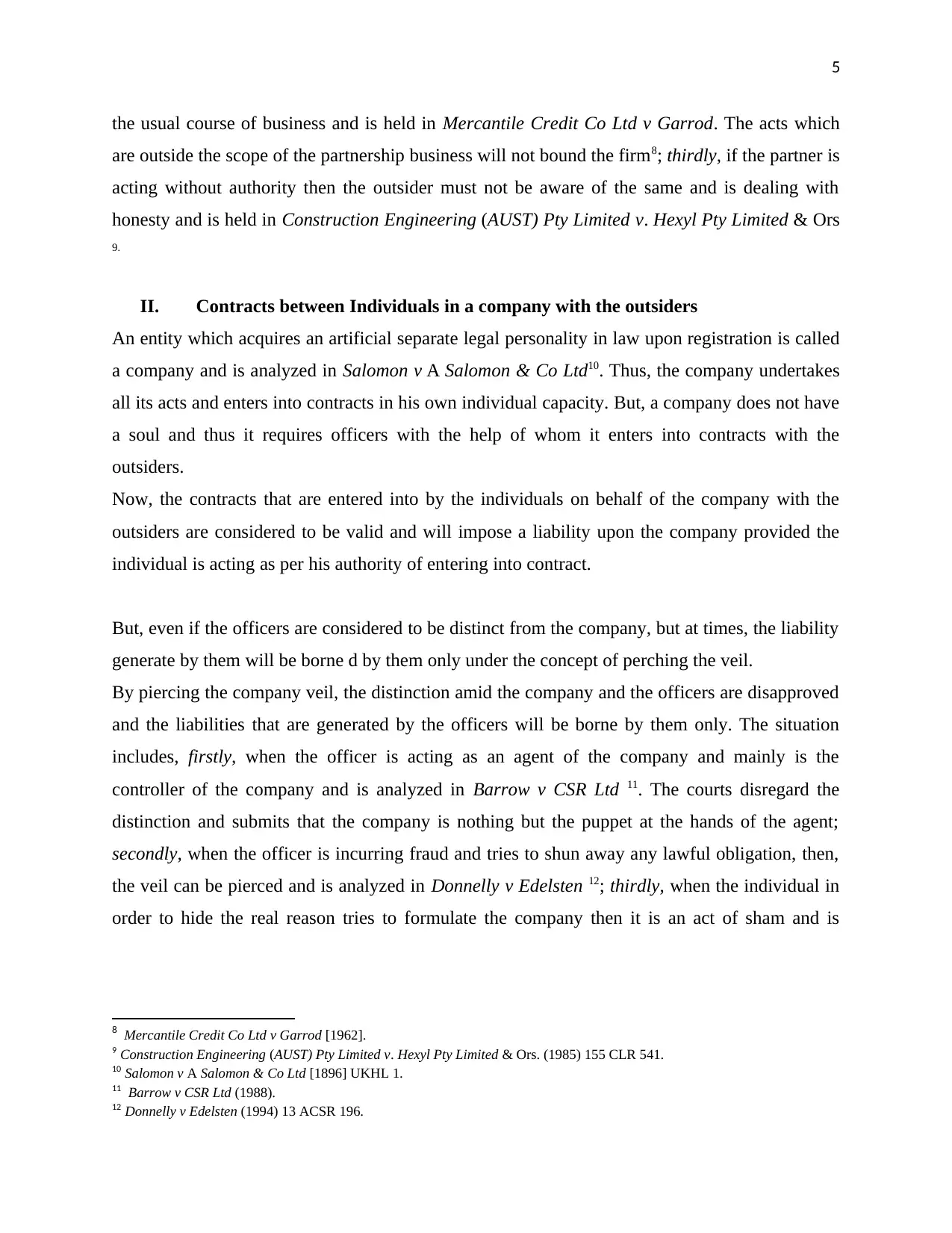
5
the usual course of business and is held in Mercantile Credit Co Ltd v Garrod. The acts which
are outside the scope of the partnership business will not bound the firm8; thirdly, if the partner is
acting without authority then the outsider must not be aware of the same and is dealing with
honesty and is held in Construction Engineering (AUST) Pty Limited v. Hexyl Pty Limited & Ors
9.
II. Contracts between Individuals in a company with the outsiders
An entity which acquires an artificial separate legal personality in law upon registration is called
a company and is analyzed in Salomon v A Salomon & Co Ltd10. Thus, the company undertakes
all its acts and enters into contracts in his own individual capacity. But, a company does not have
a soul and thus it requires officers with the help of whom it enters into contracts with the
outsiders.
Now, the contracts that are entered into by the individuals on behalf of the company with the
outsiders are considered to be valid and will impose a liability upon the company provided the
individual is acting as per his authority of entering into contract.
But, even if the officers are considered to be distinct from the company, but at times, the liability
generate by them will be borne d by them only under the concept of perching the veil.
By piercing the company veil, the distinction amid the company and the officers are disapproved
and the liabilities that are generated by the officers will be borne by them only. The situation
includes, firstly, when the officer is acting as an agent of the company and mainly is the
controller of the company and is analyzed in Barrow v CSR Ltd 11. The courts disregard the
distinction and submits that the company is nothing but the puppet at the hands of the agent;
secondly, when the officer is incurring fraud and tries to shun away any lawful obligation, then,
the veil can be pierced and is analyzed in Donnelly v Edelsten 12; thirdly, when the individual in
order to hide the real reason tries to formulate the company then it is an act of sham and is
8 Mercantile Credit Co Ltd v Garrod [1962].
9 Construction Engineering (AUST) Pty Limited v. Hexyl Pty Limited & Ors. (1985) 155 CLR 541.
10 Salomon v A Salomon & Co Ltd [1896] UKHL 1.
11 Barrow v CSR Ltd (1988).
12 Donnelly v Edelsten (1994) 13 ACSR 196.
the usual course of business and is held in Mercantile Credit Co Ltd v Garrod. The acts which
are outside the scope of the partnership business will not bound the firm8; thirdly, if the partner is
acting without authority then the outsider must not be aware of the same and is dealing with
honesty and is held in Construction Engineering (AUST) Pty Limited v. Hexyl Pty Limited & Ors
9.
II. Contracts between Individuals in a company with the outsiders
An entity which acquires an artificial separate legal personality in law upon registration is called
a company and is analyzed in Salomon v A Salomon & Co Ltd10. Thus, the company undertakes
all its acts and enters into contracts in his own individual capacity. But, a company does not have
a soul and thus it requires officers with the help of whom it enters into contracts with the
outsiders.
Now, the contracts that are entered into by the individuals on behalf of the company with the
outsiders are considered to be valid and will impose a liability upon the company provided the
individual is acting as per his authority of entering into contract.
But, even if the officers are considered to be distinct from the company, but at times, the liability
generate by them will be borne d by them only under the concept of perching the veil.
By piercing the company veil, the distinction amid the company and the officers are disapproved
and the liabilities that are generated by the officers will be borne by them only. The situation
includes, firstly, when the officer is acting as an agent of the company and mainly is the
controller of the company and is analyzed in Barrow v CSR Ltd 11. The courts disregard the
distinction and submits that the company is nothing but the puppet at the hands of the agent;
secondly, when the officer is incurring fraud and tries to shun away any lawful obligation, then,
the veil can be pierced and is analyzed in Donnelly v Edelsten 12; thirdly, when the individual in
order to hide the real reason tries to formulate the company then it is an act of sham and is
8 Mercantile Credit Co Ltd v Garrod [1962].
9 Construction Engineering (AUST) Pty Limited v. Hexyl Pty Limited & Ors. (1985) 155 CLR 541.
10 Salomon v A Salomon & Co Ltd [1896] UKHL 1.
11 Barrow v CSR Ltd (1988).
12 Donnelly v Edelsten (1994) 13 ACSR 196.
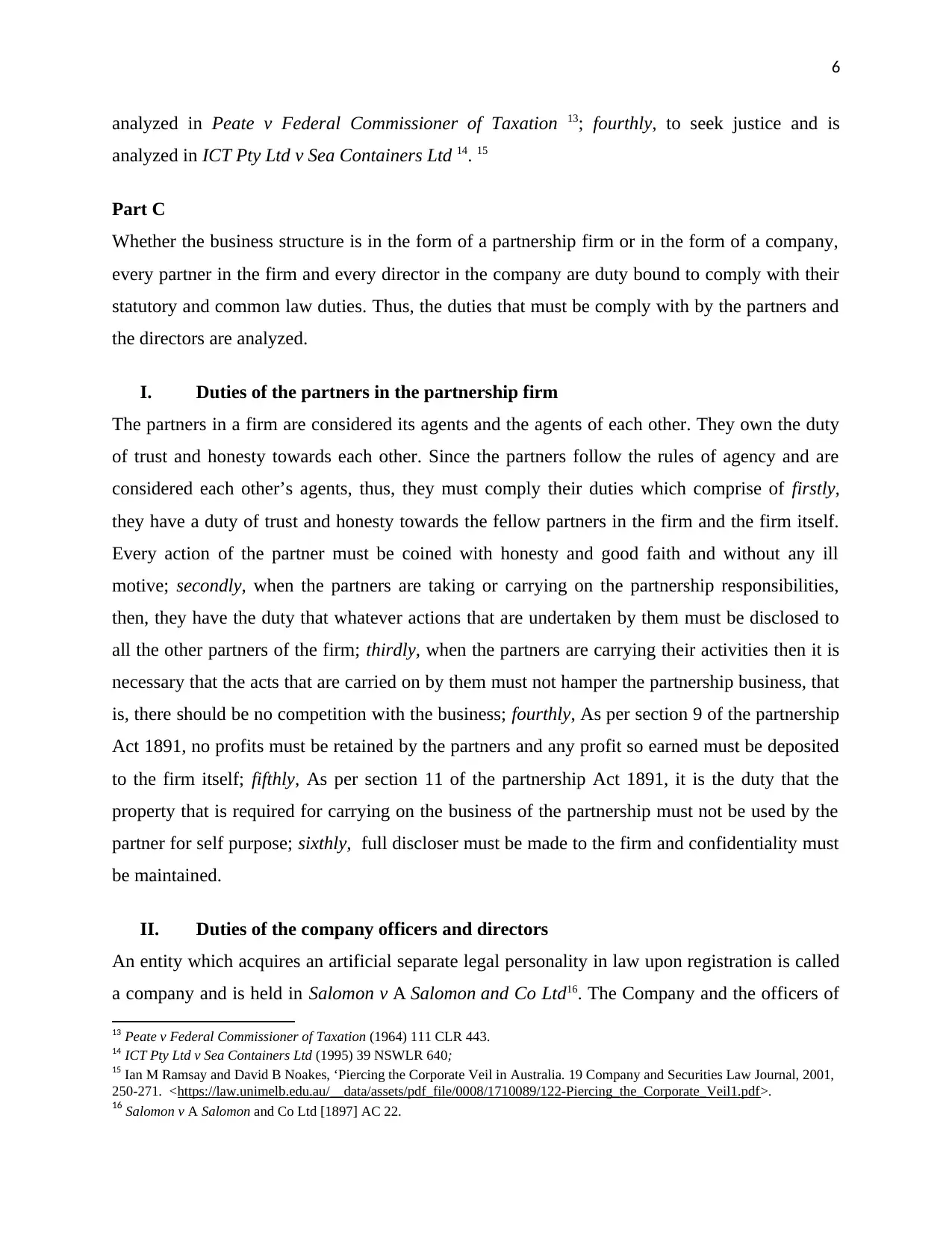
6
analyzed in Peate v Federal Commissioner of Taxation 13; fourthly, to seek justice and is
analyzed in ICT Pty Ltd v Sea Containers Ltd 14. 15
Part C
Whether the business structure is in the form of a partnership firm or in the form of a company,
every partner in the firm and every director in the company are duty bound to comply with their
statutory and common law duties. Thus, the duties that must be comply with by the partners and
the directors are analyzed.
I. Duties of the partners in the partnership firm
The partners in a firm are considered its agents and the agents of each other. They own the duty
of trust and honesty towards each other. Since the partners follow the rules of agency and are
considered each other’s agents, thus, they must comply their duties which comprise of firstly,
they have a duty of trust and honesty towards the fellow partners in the firm and the firm itself.
Every action of the partner must be coined with honesty and good faith and without any ill
motive; secondly, when the partners are taking or carrying on the partnership responsibilities,
then, they have the duty that whatever actions that are undertaken by them must be disclosed to
all the other partners of the firm; thirdly, when the partners are carrying their activities then it is
necessary that the acts that are carried on by them must not hamper the partnership business, that
is, there should be no competition with the business; fourthly, As per section 9 of the partnership
Act 1891, no profits must be retained by the partners and any profit so earned must be deposited
to the firm itself; fifthly, As per section 11 of the partnership Act 1891, it is the duty that the
property that is required for carrying on the business of the partnership must not be used by the
partner for self purpose; sixthly, full discloser must be made to the firm and confidentiality must
be maintained.
II. Duties of the company officers and directors
An entity which acquires an artificial separate legal personality in law upon registration is called
a company and is held in Salomon v A Salomon and Co Ltd16. The Company and the officers of
13 Peate v Federal Commissioner of Taxation (1964) 111 CLR 443.
14 ICT Pty Ltd v Sea Containers Ltd (1995) 39 NSWLR 640;
15 Ian M Ramsay and David B Noakes, ‘Piercing the Corporate Veil in Australia. 19 Company and Securities Law Journal, 2001,
250-271. <https://law.unimelb.edu.au/__data/assets/pdf_file/0008/1710089/122-Piercing_the_Corporate_Veil1.pdf>.
16 Salomon v A Salomon and Co Ltd [1897] AC 22.
analyzed in Peate v Federal Commissioner of Taxation 13; fourthly, to seek justice and is
analyzed in ICT Pty Ltd v Sea Containers Ltd 14. 15
Part C
Whether the business structure is in the form of a partnership firm or in the form of a company,
every partner in the firm and every director in the company are duty bound to comply with their
statutory and common law duties. Thus, the duties that must be comply with by the partners and
the directors are analyzed.
I. Duties of the partners in the partnership firm
The partners in a firm are considered its agents and the agents of each other. They own the duty
of trust and honesty towards each other. Since the partners follow the rules of agency and are
considered each other’s agents, thus, they must comply their duties which comprise of firstly,
they have a duty of trust and honesty towards the fellow partners in the firm and the firm itself.
Every action of the partner must be coined with honesty and good faith and without any ill
motive; secondly, when the partners are taking or carrying on the partnership responsibilities,
then, they have the duty that whatever actions that are undertaken by them must be disclosed to
all the other partners of the firm; thirdly, when the partners are carrying their activities then it is
necessary that the acts that are carried on by them must not hamper the partnership business, that
is, there should be no competition with the business; fourthly, As per section 9 of the partnership
Act 1891, no profits must be retained by the partners and any profit so earned must be deposited
to the firm itself; fifthly, As per section 11 of the partnership Act 1891, it is the duty that the
property that is required for carrying on the business of the partnership must not be used by the
partner for self purpose; sixthly, full discloser must be made to the firm and confidentiality must
be maintained.
II. Duties of the company officers and directors
An entity which acquires an artificial separate legal personality in law upon registration is called
a company and is held in Salomon v A Salomon and Co Ltd16. The Company and the officers of
13 Peate v Federal Commissioner of Taxation (1964) 111 CLR 443.
14 ICT Pty Ltd v Sea Containers Ltd (1995) 39 NSWLR 640;
15 Ian M Ramsay and David B Noakes, ‘Piercing the Corporate Veil in Australia. 19 Company and Securities Law Journal, 2001,
250-271. <https://law.unimelb.edu.au/__data/assets/pdf_file/0008/1710089/122-Piercing_the_Corporate_Veil1.pdf>.
16 Salomon v A Salomon and Co Ltd [1897] AC 22.
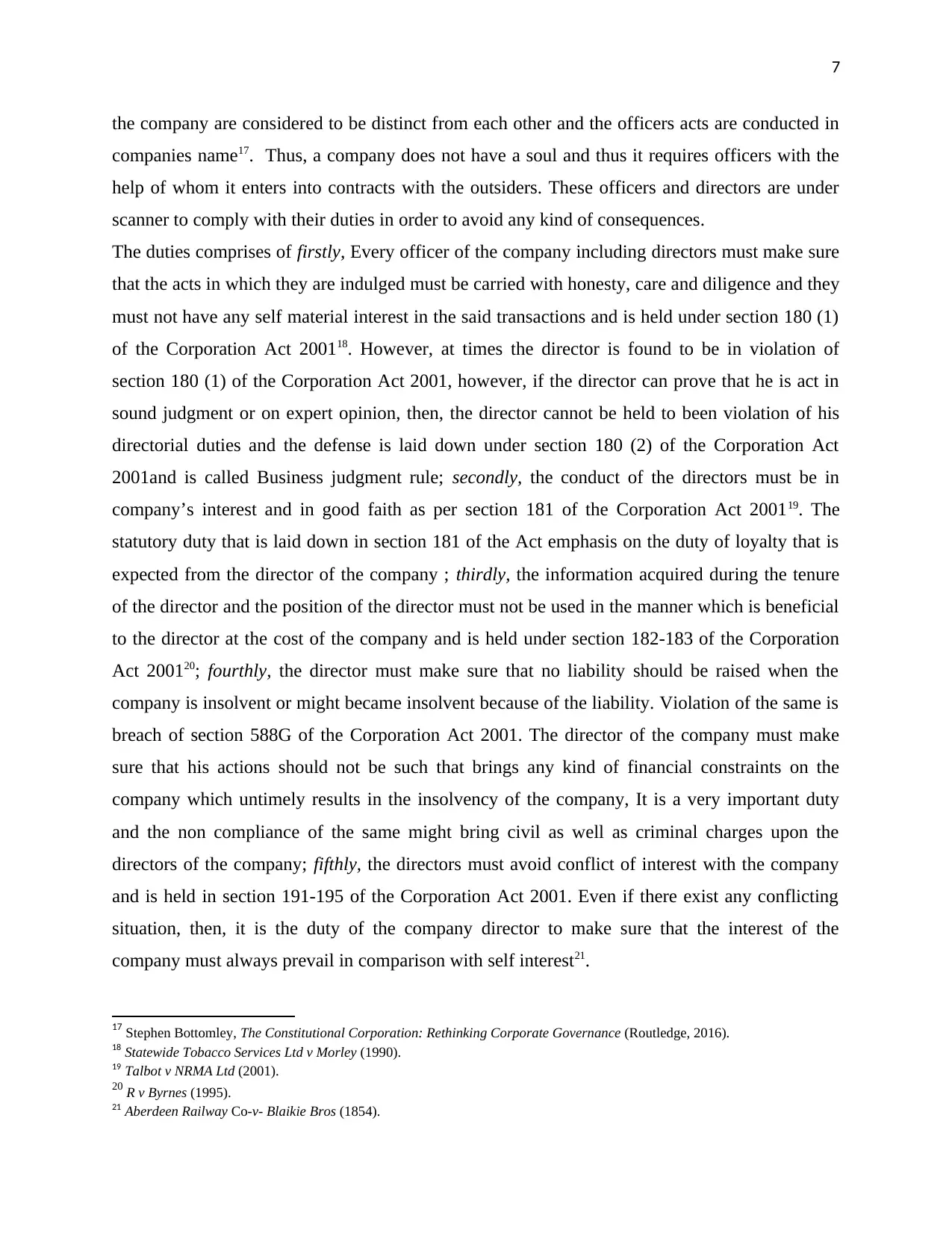
7
the company are considered to be distinct from each other and the officers acts are conducted in
companies name17. Thus, a company does not have a soul and thus it requires officers with the
help of whom it enters into contracts with the outsiders. These officers and directors are under
scanner to comply with their duties in order to avoid any kind of consequences.
The duties comprises of firstly, Every officer of the company including directors must make sure
that the acts in which they are indulged must be carried with honesty, care and diligence and they
must not have any self material interest in the said transactions and is held under section 180 (1)
of the Corporation Act 200118. However, at times the director is found to be in violation of
section 180 (1) of the Corporation Act 2001, however, if the director can prove that he is act in
sound judgment or on expert opinion, then, the director cannot be held to been violation of his
directorial duties and the defense is laid down under section 180 (2) of the Corporation Act
2001and is called Business judgment rule; secondly, the conduct of the directors must be in
company’s interest and in good faith as per section 181 of the Corporation Act 200119. The
statutory duty that is laid down in section 181 of the Act emphasis on the duty of loyalty that is
expected from the director of the company ; thirdly, the information acquired during the tenure
of the director and the position of the director must not be used in the manner which is beneficial
to the director at the cost of the company and is held under section 182-183 of the Corporation
Act 200120; fourthly, the director must make sure that no liability should be raised when the
company is insolvent or might became insolvent because of the liability. Violation of the same is
breach of section 588G of the Corporation Act 2001. The director of the company must make
sure that his actions should not be such that brings any kind of financial constraints on the
company which untimely results in the insolvency of the company, It is a very important duty
and the non compliance of the same might bring civil as well as criminal charges upon the
directors of the company; fifthly, the directors must avoid conflict of interest with the company
and is held in section 191-195 of the Corporation Act 2001. Even if there exist any conflicting
situation, then, it is the duty of the company director to make sure that the interest of the
company must always prevail in comparison with self interest21.
17 Stephen Bottomley, The Constitutional Corporation: Rethinking Corporate Governance (Routledge, 2016).
18 Statewide Tobacco Services Ltd v Morley (1990).
19 Talbot v NRMA Ltd (2001).
20 R v Byrnes (1995).
21 Aberdeen Railway Co-v- Blaikie Bros (1854).
the company are considered to be distinct from each other and the officers acts are conducted in
companies name17. Thus, a company does not have a soul and thus it requires officers with the
help of whom it enters into contracts with the outsiders. These officers and directors are under
scanner to comply with their duties in order to avoid any kind of consequences.
The duties comprises of firstly, Every officer of the company including directors must make sure
that the acts in which they are indulged must be carried with honesty, care and diligence and they
must not have any self material interest in the said transactions and is held under section 180 (1)
of the Corporation Act 200118. However, at times the director is found to be in violation of
section 180 (1) of the Corporation Act 2001, however, if the director can prove that he is act in
sound judgment or on expert opinion, then, the director cannot be held to been violation of his
directorial duties and the defense is laid down under section 180 (2) of the Corporation Act
2001and is called Business judgment rule; secondly, the conduct of the directors must be in
company’s interest and in good faith as per section 181 of the Corporation Act 200119. The
statutory duty that is laid down in section 181 of the Act emphasis on the duty of loyalty that is
expected from the director of the company ; thirdly, the information acquired during the tenure
of the director and the position of the director must not be used in the manner which is beneficial
to the director at the cost of the company and is held under section 182-183 of the Corporation
Act 200120; fourthly, the director must make sure that no liability should be raised when the
company is insolvent or might became insolvent because of the liability. Violation of the same is
breach of section 588G of the Corporation Act 2001. The director of the company must make
sure that his actions should not be such that brings any kind of financial constraints on the
company which untimely results in the insolvency of the company, It is a very important duty
and the non compliance of the same might bring civil as well as criminal charges upon the
directors of the company; fifthly, the directors must avoid conflict of interest with the company
and is held in section 191-195 of the Corporation Act 2001. Even if there exist any conflicting
situation, then, it is the duty of the company director to make sure that the interest of the
company must always prevail in comparison with self interest21.
17 Stephen Bottomley, The Constitutional Corporation: Rethinking Corporate Governance (Routledge, 2016).
18 Statewide Tobacco Services Ltd v Morley (1990).
19 Talbot v NRMA Ltd (2001).
20 R v Byrnes (1995).
21 Aberdeen Railway Co-v- Blaikie Bros (1854).
Paraphrase This Document
Need a fresh take? Get an instant paraphrase of this document with our AI Paraphraser

8
Thus, these are some of the fundamental duties that must be comply with by the directors of the
company.
Thus, these are some of the fundamental duties that must be comply with by the directors of the
company.
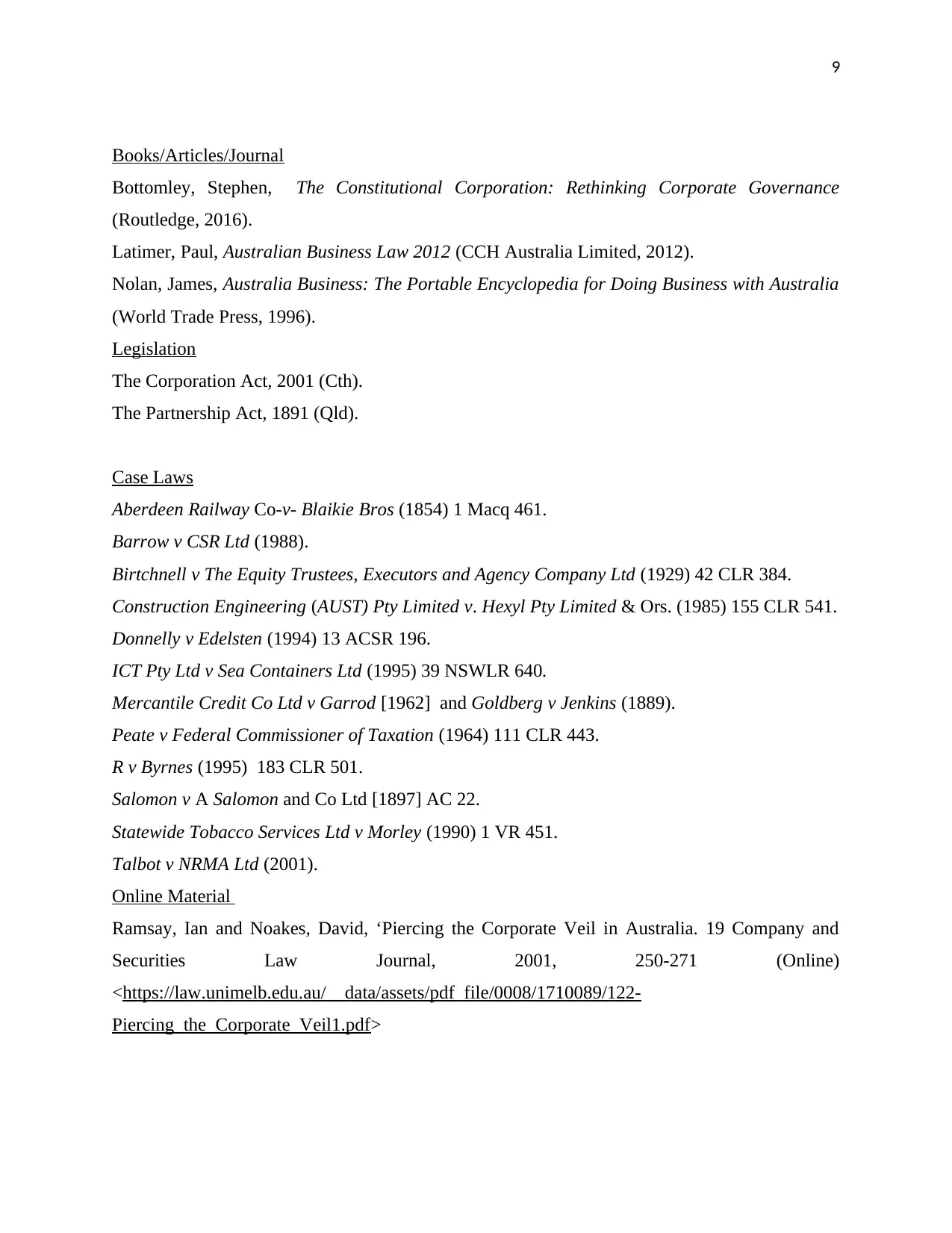
9
Books/Articles/Journal
Bottomley, Stephen, The Constitutional Corporation: Rethinking Corporate Governance
(Routledge, 2016).
Latimer, Paul, Australian Business Law 2012 (CCH Australia Limited, 2012).
Nolan, James, Australia Business: The Portable Encyclopedia for Doing Business with Australia
(World Trade Press, 1996).
Legislation
The Corporation Act, 2001 (Cth).
The Partnership Act, 1891 (Qld).
Case Laws
Aberdeen Railway Co-v- Blaikie Bros (1854) 1 Macq 461.
Barrow v CSR Ltd (1988).
Birtchnell v The Equity Trustees, Executors and Agency Company Ltd (1929) 42 CLR 384.
Construction Engineering (AUST) Pty Limited v. Hexyl Pty Limited & Ors. (1985) 155 CLR 541.
Donnelly v Edelsten (1994) 13 ACSR 196.
ICT Pty Ltd v Sea Containers Ltd (1995) 39 NSWLR 640.
Mercantile Credit Co Ltd v Garrod [1962] and Goldberg v Jenkins (1889).
Peate v Federal Commissioner of Taxation (1964) 111 CLR 443.
R v Byrnes (1995) 183 CLR 501.
Salomon v A Salomon and Co Ltd [1897] AC 22.
Statewide Tobacco Services Ltd v Morley (1990) 1 VR 451.
Talbot v NRMA Ltd (2001).
Online Material
Ramsay, Ian and Noakes, David, ‘Piercing the Corporate Veil in Australia. 19 Company and
Securities Law Journal, 2001, 250-271 (Online)
<https://law.unimelb.edu.au/__data/assets/pdf_file/0008/1710089/122-
Piercing_the_Corporate_Veil1.pdf>
Books/Articles/Journal
Bottomley, Stephen, The Constitutional Corporation: Rethinking Corporate Governance
(Routledge, 2016).
Latimer, Paul, Australian Business Law 2012 (CCH Australia Limited, 2012).
Nolan, James, Australia Business: The Portable Encyclopedia for Doing Business with Australia
(World Trade Press, 1996).
Legislation
The Corporation Act, 2001 (Cth).
The Partnership Act, 1891 (Qld).
Case Laws
Aberdeen Railway Co-v- Blaikie Bros (1854) 1 Macq 461.
Barrow v CSR Ltd (1988).
Birtchnell v The Equity Trustees, Executors and Agency Company Ltd (1929) 42 CLR 384.
Construction Engineering (AUST) Pty Limited v. Hexyl Pty Limited & Ors. (1985) 155 CLR 541.
Donnelly v Edelsten (1994) 13 ACSR 196.
ICT Pty Ltd v Sea Containers Ltd (1995) 39 NSWLR 640.
Mercantile Credit Co Ltd v Garrod [1962] and Goldberg v Jenkins (1889).
Peate v Federal Commissioner of Taxation (1964) 111 CLR 443.
R v Byrnes (1995) 183 CLR 501.
Salomon v A Salomon and Co Ltd [1897] AC 22.
Statewide Tobacco Services Ltd v Morley (1990) 1 VR 451.
Talbot v NRMA Ltd (2001).
Online Material
Ramsay, Ian and Noakes, David, ‘Piercing the Corporate Veil in Australia. 19 Company and
Securities Law Journal, 2001, 250-271 (Online)
<https://law.unimelb.edu.au/__data/assets/pdf_file/0008/1710089/122-
Piercing_the_Corporate_Veil1.pdf>
1 out of 9
Related Documents
Your All-in-One AI-Powered Toolkit for Academic Success.
+13062052269
info@desklib.com
Available 24*7 on WhatsApp / Email
![[object Object]](/_next/static/media/star-bottom.7253800d.svg)
Unlock your academic potential
© 2024 | Zucol Services PVT LTD | All rights reserved.





